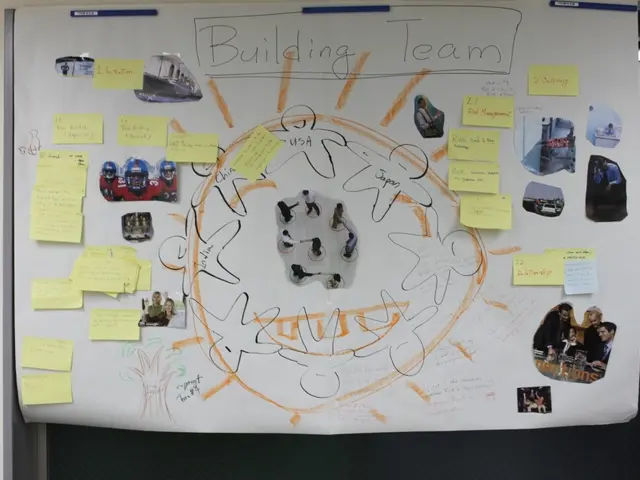Tumors manifesting drug resistance: An explanation
New Take on Cancer Treatment:
Research conducted at MIT reveals a potential breakthrough in the fight against drug-resistant cancers. The focus is on ErbB inhibitors, a type of cancer drug that's been successful in treating various forms of lung, breast, and colon cancer. However, resistance to these drugs has been a persistent issue, leading to the study of the protein AXL.
Doug Lauffenburger, the Ford Professor of Bioengineering and senior author of the paper, explains the predicament, "Drug resistance is the major challenge in cancer these days. People are coming up with lots of targeted therapies for particular genes, but resistance is always the issue."
In the study, Lauffenburger and his team used systems analysis to identify factors that contribute to tumor cell resistance to EGFR and other ErbB inhibitors. They discovered that the EGFR protein, when paired with the AXL receptor, is the most significant marker for EGFR inhibitor resistance. This finding was consistent across multiple cancer types, including lung, breast, and pancreatic.
The researchers then observed that AXL tends to cluster with EGFR on cell surfaces, enabling it to become active when EGFR is. AXL stimulates the same cellular machinery targeted by EGFR but also activates additional pathways leading to cell growth and division. AXL also enhances cell motility, allowing cancer cells to spread throughout the body.
The study suggests that AXL inhibition may not only be effective for treating cancer cells that overexpress EGFR but also those dependent on ErbB2 or those with high levels of ErbB3. The findings could pave the way for new treatments for triple-negative breast cancer, which has proven resistant to EGFR inhibitors.
Groundbreaking research such as this exemplifies the importance of systems biology, a field that focuses on complex interactions within biological systems. As Lauffenburger explains, "You've got to look at pathways in combination, you've got to look at whole interacting networks. That's the only way."
In the future, clinical trials will be essential to evaluate the safety and efficacy of combining ErbB and AXL inhibitors in various cancer types. Identifying biomarkers to predict responsiveness to this combination therapy is also crucial, as is understanding the molecular mechanisms underlying the synergistic effects of these inhibitors to optimize their use in cancer treatment.
Insight: ErbB and AXL inhibitors could offer a promising approach in treating drug-resistant cancers. By combining these inhibitors, researchers may be able to dismantle cancer cell survival mechanisms, reduce the likelihood of developing resistance, and potentially improve patient outcomes.
Potential Treatments:
- ErbB Inhibitors: These drugs, such as trastuzumab and lapatinib, target cell proliferation and survival pathways associated with the ErbB family, including EGFR and HER2 (ErbB2).
- AXL Inhibitors: Inhibiting AXL can disrupt cell migration, survival, and resistance to apoptosis, potentially sensitizing cancer cells to other treatments.
Combination Therapy: By simultaneously targeting multiple pathways, this dual inhibition approach could lead to a more comprehensive disruption of cancer cell survival mechanisms, reduce the likelihood of developing resistance, and potentially improve patient outcomes.
Future Directions: To fully exploit this approach, research should focus on conducting clinical trials, identifying biomarkers for responsiveness, and investigating the molecular mechanisms underlying the synergistic effects of these inhibitors.
- The discovery in the study has significant implications for the field of research, as it sheds light on potential breakthroughs in learning about drug-resistant cancers.
- The focus of the research conducted at MIT was on ErbB inhibitors, a type of cancer drug that has shown success in treating various forms of lung, breast, and colon cancer, but has faced persistent issues with resistance.
- In the realm of health-and-wellness, the push for advancements in medicine and science is driven by the pressing need to address medical-conditions like cancer, especially drug-resistant ones, where progress has been slow.
- The news of this study, which suggests that AXL inhibition may be effective for treating cancer cells that overexpress EGFR and those dependent on ErbB2 or those with high levels of ErbB3, has sparked renewed interest in press discussions about potential treatments for drug-resistant cancers.
- As the study demonstrates, understanding the complex interactions within biological systems, as delved into by the field of systems biology, is crucial in learning about the intricacies of cancers like drug-resistant ones and in developing effective treatments like ErbB and AXL inhibitors.
- The finding that AXL can stimulate the same cellular machinery targeted by EGFR and activate additional pathways leading to cell growth and division is of immense importance in the field of neurological-disorders, as it expands the knowledge about the mechanisms behind cell division, which is key in understanding and combating diseases like cancer.
- For the improvement of mental-health outcomes, continuous learning and research are essential, as they contribute to the development of new treatment strategies for complex diseases like cancer, and ultimately strive to foster a better understanding of health and wellness.







